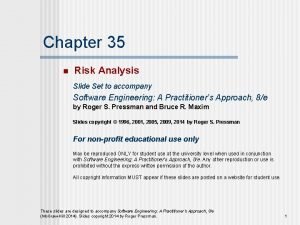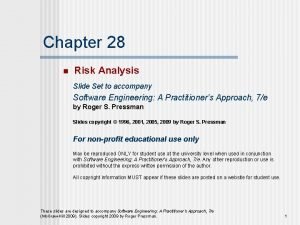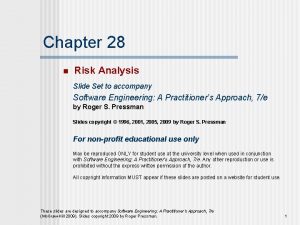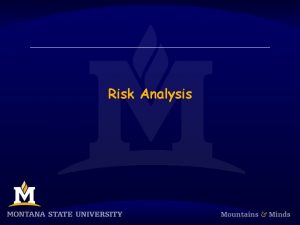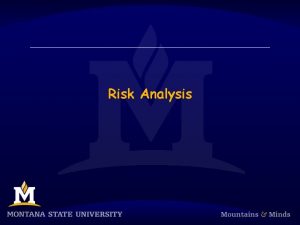Chapter 28 n Risk Analysis Slide Set to





















- Slides: 21

Chapter 28 n Risk Analysis Slide Set to accompany Software Engineering: A Practitioner’s Approach, 7/e by Roger S. Pressman Slides copyright © 1996, 2001, 2005, 2009 by Roger S. Pressman For non-profit educational use only May be reproduced ONLY for student use at the university level when used in conjunction with Software Engineering: A Practitioner's Approach, 7/e. Any other reproduction or use is prohibited without the express written permission of the author. All copyright information MUST appear if these slides are posted on a website for student use. These slides are designed to accompany Software Engineering: A Practitioner’s Approach, 7/e (Mc. Graw-Hill 2009). Slides copyright 2009 by Roger Pressman. 1

Project Risks What can go wrong? What is the likelihood? What will the damage be? What can we do about it? These slides are designed to accompany Software Engineering: A Practitioner’s Approach, 7/e (Mc. Graw-Hill 2009). Slides copyright 2009 by Roger Pressman. 2

Reactive Risk Management n n project team reacts to risks when they occur mitigation—plan for additional resources in anticipation of fire fighting fix on failure—resource are found applied when the risk strikes crisis management—failure does not respond to applied resources and project is in jeopardy These slides are designed to accompany Software Engineering: A Practitioner’s Approach, 7/e (Mc. Graw-Hill 2009). Slides copyright 2009 by Roger Pressman. 3

Proactive Risk Management n n formal risk analysis is performed organization corrects the root causes of risk n n n TQM concepts and statistical SQA examining risk sources that lie beyond the bounds of the software developing the skill to manage change These slides are designed to accompany Software Engineering: A Practitioner’s Approach, 7/e (Mc. Graw-Hill 2009). Slides copyright 2009 by Roger Pressman. 4

Seven Principles n n n n Maintain a global perspective—view software risks within the context of system and the business problem Take a forward-looking view—think about the risks that may arise in the future; establish contingency plans Encourage open communication—if someone states a potential risk, don’t discount it. Integrate—a consideration of risk must be integrated into the software process Emphasize a continuous process—the team must be vigilant throughout the software process, modifying identified risks as more information is known and adding new ones as better insight is achieved. Develop a shared product vision—if all stakeholders share the same vision of the software, it likely that better risk identification and assessment will occur. Encourage teamwork—the talents, skills and knowledge of all stakeholder should be pooled These slides are designed to accompany Software Engineering: A Practitioner’s Approach, 7/e (Mc. Graw-Hill 2009). Slides copyright 2009 by Roger Pressman. 5

Risk Management Paradigm control track RISK identify plan analyze These slides are designed to accompany Software Engineering: A Practitioner’s Approach, 7/e (Mc. Graw-Hill 2009). Slides copyright 2009 by Roger Pressman. 6

Risk Identification n n n Product size—risks associated with the overall size of the software to be built or modified. Business impact—risks associated with constraints imposed by management or the marketplace. Customer characteristics—risks associated with the sophistication of the customer and the developer's ability to communicate with the customer in a timely manner. Process definition—risks associated with the degree to which the software process has been defined and is followed by the development organization. Development environment—risks associated with the availability and quality of the tools to be used to build the product. Technology to be built—risks associated with the complexity of the system to be built and the "newness" of the technology that is packaged by the system. Staff size and experience—risks associated with the overall technical and project experience of the software engineers who will do the work. These slides are designed to accompany Software Engineering: A Practitioner’s Approach, 7/e (Mc. Graw-Hill 2009). Slides copyright 2009 by Roger Pressman. 7

Assessing Project Risk-I n n n Have top software and customer managers formally committed to support the project? Are end-users enthusiastically committed to the project and the system/product to be built? Are requirements fully understood by the software engineering team and their customers? Have customers been involved fully in the definition of requirements? Do end-users have realistic expectations? These slides are designed to accompany Software Engineering: A Practitioner’s Approach, 7/e (Mc. Graw-Hill 2009). Slides copyright 2009 by Roger Pressman. 8

Assessing Project Risk-II n n n Is project scope stable? Does the software engineering team have the right mix of skills? Are project requirements stable? Does the project team have experience with the technology to be implemented? Is the number of people on the project team adequate to do the job? Do all customer/user constituencies agree on the importance of the project and on the requirements for the system/product to be built? These slides are designed to accompany Software Engineering: A Practitioner’s Approach, 7/e (Mc. Graw-Hill 2009). Slides copyright 2009 by Roger Pressman. 9

Risk Projection n Risk projection, also called risk estimation, attempts to rate each risk in two ways n n n the likelihood or probability that the risk is real the consequences of the problems associated with the risk, should it occur. The are four risk projection steps: n n establish a scale that reflects the perceived likelihood of a risk delineate the consequences of the risk estimate the impact of the risk on the project and the product, note the overall accuracy of the risk projection so that there will be no misunderstandings. These slides are designed to accompany Software Engineering: A Practitioner’s Approach, 7/e (Mc. Graw-Hill 2009). Slides copyright 2009 by Roger Pressman. 10

Building a Risk Table Risk Probability Impact RMMM Risk Mitigation Monitoring & Management These slides are designed to accompany Software Engineering: A Practitioner’s Approach, 7/e (Mc. Graw-Hill 2009). Slides copyright 2009 by Roger Pressman. 11

Building the Risk Table n n Estimate the probability of occurrence Estimate the impact on the project on a scale of 1 to 5, where n n n 1 = low impact on project success 5 = catastrophic impact on project success sort the table by probability and impact These slides are designed to accompany Software Engineering: A Practitioner’s Approach, 7/e (Mc. Graw-Hill 2009). Slides copyright 2009 by Roger Pressman. 12

Risk Exposure (Impact) The overall risk exposure, RE, is determined using the following relationship [Hal 98]: RE = P x C where P is the probability of occurrence for a risk, and C is the cost to the project should the risk occur. These slides are designed to accompany Software Engineering: A Practitioner’s Approach, 7/e (Mc. Graw-Hill 2009). Slides copyright 2009 by Roger Pressman. 13

Risk Mitigation, Monitoring, and Management n n n mitigation—how can we avoid the risk? monitoring—what factors can we track that will enable us to determine if the risk is becoming more or less likely? management—what contingency plans do we have if the risk becomes a reality? These slides are designed to accompany Software Engineering: A Practitioner’s Approach, 7/e (Mc. Graw-Hill 2009). Slides copyright 2009 by Roger Pressman. 14

Risk Due to Product Size Attributes that affect risk: • estimated size of the product in LOC or FP? • estimated size of product in number of programs, files, transactions? • percentage deviation in size of product from average for previous products? • size of database created or used by the product? • number of users of the product? • number of projected changes to the requirements for the product? before delivery? after delivery? • amount of reused software? These slides are designed to accompany Software Engineering: A Practitioner’s Approach, 7/e (Mc. Graw-Hill 2009). Slides copyright 2009 by Roger Pressman. 15

Risk Due to Business Impact Attributes that affect risk: • affect of this product on company revenue? • visibility of this product by senior management? • reasonableness of delivery deadline? • number of customers who will use this product • interoperability constraints • sophistication of end users? • amount and quality of product documentation that must be produced and delivered to the customer? • governmental constraints • costs associated with late delivery? • costs associated with a defective product? These slides are designed to accompany Software Engineering: A Practitioner’s Approach, 7/e (Mc. Graw-Hill 2009). Slides copyright 2009 by Roger Pressman. 16

Risks Due to the Customer Questions that must be answered: • Have you worked with the customer in the past? • Does the customer have a solid idea of requirements? • Has the customer agreed to spend time with you? • Is the customer willing to participate in reviews? • Is the customer technically sophisticated? • Is the customer willing to let your people do their job—that is, will the customer resist looking over your shoulder during technically detailed work? • Does the customer understand the software engineering process? These slides are designed to accompany Software Engineering: A Practitioner’s Approach, 7/e (Mc. Graw-Hill 2009). Slides copyright 2009 by Roger Pressman. 17

Risks Due to Process Maturity Questions that must be answered: • Have you established a common process framework? • Is it followed by project teams? • Do you have management support for software engineering • Do you have a proactive approach to SQA? • Do you conduct formal technical reviews? • Are CASE tools used for analysis, design and testing? • Are the tools integrated with one another? • Have document formats been established? These slides are designed to accompany Software Engineering: A Practitioner’s Approach, 7/e (Mc. Graw-Hill 2009). Slides copyright 2009 by Roger Pressman. 18

Technology Risks Questions that must be answered: • • Is the technology new to your organization? Are new algorithms, I/O technology required? Is new or unproven hardware involved? Does the application interface with new software? Is a specialized user interface required? Is the application radically different? Are you using new software engineering methods? • Are you using unconventional software development methods, such as formal methods, AI-based approaches, artificial neural networks? • Are there significant performance constraints? • Is there doubt the functionality requested is "do-able? " These slides are designed to accompany Software Engineering: A Practitioner’s Approach, 7/e (Mc. Graw-Hill 2009). Slides copyright 2009 by Roger Pressman. 19

Staff/People Risks Questions that must be answered: • • Are the best people available? Does staff have the right skills? Are enough people available? Are staff committed for entire duration? Will some people work part time? Do staff have the right expectations? Have staff received necessary training? Will turnover among staff be low? These slides are designed to accompany Software Engineering: A Practitioner’s Approach, 7/e (Mc. Graw-Hill 2009). Slides copyright 2009 by Roger Pressman. 20

Recording Risk Information Project: Embedded software for XYZ system Risk type: schedule risk Priority (1 low. . . 5 critical): 4 Risk factor: Project completion will depend on tests which require hardware component under development. Hardware component delivery may be delayed Probability: 60 % Impact: Project completion will be delayed for each day that hardware is unavailable for use in software testing Monitoring approach: Scheduled milestone reviews with hardware group Contingency plan: Modification of testing strategy to accommodate delay using software simulation Estimated resources: 6 additional person months beginning in July These slides are designed to accompany Software Engineering: A Practitioner’s Approach, 7/e (Mc. Graw-Hill 2009). Slides copyright 2009 by Roger Pressman. 21
 Toe and heel dance
Toe and heel dance Total set awareness set consideration set
Total set awareness set consideration set Training set validation set test set
Training set validation set test set Market risk credit risk operational risk
Market risk credit risk operational risk Factoring problems
Factoring problems Bounded set vs centered set
Bounded set vs centered set Fuzzy theory
Fuzzy theory Crisp set vs fuzzy set
Crisp set vs fuzzy set Crisp set vs fuzzy set
Crisp set vs fuzzy set What is the overlap of data set 1 and data set 2?
What is the overlap of data set 1 and data set 2? Correspondence function examples
Correspondence function examples What is risk projection in software engineering
What is risk projection in software engineering Risk reduction vs risk avoidance
Risk reduction vs risk avoidance Absolute risk vs relative risk
Absolute risk vs relative risk Residual risk and secondary risk pmp
Residual risk and secondary risk pmp Tracing vs vouching
Tracing vs vouching Absolute risk vs relative risk
Absolute risk vs relative risk Activity sheet 3 stock market calculations answer key
Activity sheet 3 stock market calculations answer key Medium-term risk examples
Medium-term risk examples Risk financing retention adalah
Risk financing retention adalah The biggest risk is not taking any risk
The biggest risk is not taking any risk Key risk indicators template
Key risk indicators template
































